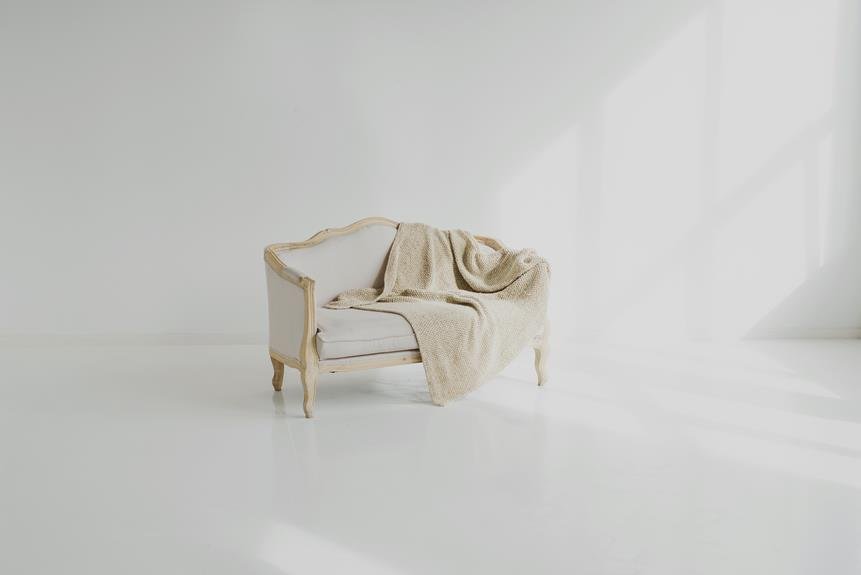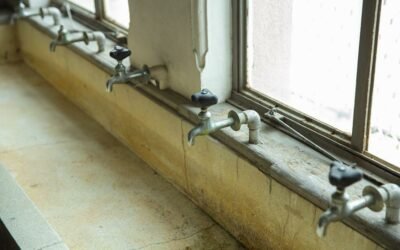Do you have mold in your upholstery? Don't worry, you can get rid of it!
In this article, we'll show you how to identify the presence of mold, prepare your upholstery for treatment, and provide DIY methods for removal.
If you prefer to leave it to the professionals, we'll also discuss hiring upholstery cleaners.
By following our suggestions, you can eliminate mold from your upholstery and prevent future growth.
Get ready to say goodbye to that pesky mold!
Key Takeaways
- Visible signs of mold in upholstery include discoloration, musty odors, and presence of mildew.
- Preparing upholstery for treatment involves removing loose items, vacuuming with a HEPA filter, and testing cleaning products on a small area.
- DIY methods for mold removal include vacuuming affected areas, using a vinegar solution or hydrogen peroxide mixture, and always testing cleaning solutions first.
- Hiring professional upholstery cleaners is recommended for severe mold infestations as they have specialized equipment, training, and safe cleaning solutions.
Identifying the Presence of Mold
To identify the presence of mold in your upholstery, you should carefully inspect the fabric and look for visible signs such as discoloration, musty odors, and the presence of mildew. Mold can often appear as patches of black, green, or white discoloration on the fabric surface. These patches may be fuzzy or have a slimy texture, indicating the growth of mold colonies.
Additionally, if your upholstery emits a musty odor, it could be a sign of mold infestation. The smell is often described as earthy or damp, similar to the scent of a basement or wet leaves.
Another telltale sign is the presence of mildew. Mildew is a fungus that commonly grows in humid environments and is often found alongside mold. It appears as a powdery, white substance on the fabric surface.
If you notice any of these visible signs, it's crucial to take immediate action to prevent further mold growth and potential health hazards.
It is important to note that mold can also grow in hidden areas of your upholstery, such as under cushions or inside the stuffing. In such cases, professional inspection and remediation may be necessary.
Regularly inspecting your upholstery and addressing any signs of mold promptly can help maintain a healthy and clean living environment.
Preparing Your Upholstery for Treatment
Before treating your upholstery for mold, gather the necessary cleaning supplies and protective gear. It's important to be well-prepared to ensure a successful treatment process.
Here's a step-by-step guide to help you prepare your upholstery for mold treatment:
- Remove any loose items: Clear the area around the affected upholstery and remove any loose items such as pillows, blankets, or decorations. This will allow you to have better access to the upholstery and prevent any obstruction during the cleaning process.
- Vacuum the upholstery: Use a vacuum cleaner with a HEPA filter to thoroughly vacuum the upholstery. This will help remove any loose mold spores and debris from the surface. Pay attention to the seams, crevices, and corners where mold can often hide.
- Test cleaning products: Before applying any cleaning solution to your upholstery, test it on a small, inconspicuous area first. This will ensure that the cleaning product doesn't cause any damage or discoloration to the fabric.
- Wear protective gear: Mold spores can be harmful when inhaled, so it's important to wear protective gear such as gloves, goggles, and a mask. This will help protect you from exposure to mold and any potentially harmful cleaning chemicals.
DIY Methods for Mold Removal
Eliminate mold from your upholstery using simple DIY methods.
When it comes to tackling mold on your upholstery, there are a few effective do-it-yourself techniques you can try. Start by thoroughly vacuuming the affected areas to remove any loose mold spores. Be sure to use a vacuum cleaner with a HEPA filter to prevent the spores from being released back into the air.
Next, mix a solution of one part white vinegar and one part water in a spray bottle. Spray the affected areas generously, making sure to saturate the upholstery. Vinegar is a natural disinfectant that can help kill mold and inhibit its growth.
After allowing the vinegar solution to sit for about an hour, use a clean cloth to blot the area and remove excess moisture.
For stubborn mold stains, you can also try using a mixture of hydrogen peroxide and water in a 1:2 ratio. Apply the solution to the stain and let it sit for 15 minutes before blotting.
Remember to always test any cleaning solution on a small, inconspicuous area of your upholstery before applying it to the entire surface.
Hiring Professional Upholstery Cleaners
Are you wondering if you should hire professional upholstery cleaners to remove mold from your furniture? While DIY methods can be effective for minor mold issues, severe mold infestations require the expertise of professionals.
Here's why hiring professional upholstery cleaners is your best option:
- Advanced equipment: Professional cleaners have access to specialized equipment and tools that are specifically designed to tackle mold. They can effectively remove mold spores from deep within the upholstery, ensuring a thorough cleaning.
- Expert knowledge: Professional upholstery cleaners are trained in identifying different types of mold and understanding their growth patterns. They can assess the severity of the mold infestation and determine the best course of action to eliminate it completely.
- Safe and effective cleaning solutions: Professionals use commercial-grade cleaning solutions that are specifically formulated to remove mold without causing any damage to the fabric or furniture. These solutions are highly effective in killing mold spores and preventing future growth.
- Preventing cross-contamination: Mold can easily spread to other areas if not handled properly. Professional cleaners take necessary precautions to prevent cross-contamination by using containment barriers and following strict cleaning protocols.
Preventing Future Mold Growth
To ensure that mold doesn't return to your upholstery, you need to take proactive steps to prevent its growth in the future.
Mold thrives in damp and humid environments, so controlling moisture levels is crucial. First, make sure your home is properly ventilated. Use exhaust fans in bathrooms and kitchens to remove excess moisture from the air. Consider installing a dehumidifier in areas that tend to be more humid, such as basements or laundry rooms.
Regularly inspect your upholstery for any signs of water damage or leaks. Address any issues immediately to prevent mold from taking hold. If you spill liquids on your upholstery, clean it up promptly and thoroughly dry the area to prevent moisture from seeping into the fabric.
It's also important to keep your upholstery clean and dry. Vacuum your upholstery regularly to remove any dust or debris that could contribute to mold growth. If you notice any musty odors, it may be a sign of mold, so take action to address it promptly.
Lastly, consider using mold-resistant fabrics or treating your upholstery with a mold-resistant spray. These products can help inhibit the growth of mold and protect your upholstery from future infestations.
Conclusion
To effectively remove mold from upholstery, it's essential to correctly identify its presence and take necessary precautions.
Preparing the upholstery for treatment is crucial, and there are various DIY methods available for mold removal. However, hiring professional upholstery cleaners is highly recommended for a thorough and effective cleaning process.
Additionally, implementing preventive measures can help minimize future mold growth and maintain a healthy environment.






0 Comments